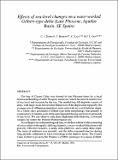Please use this identifier to cite or link to this item:
http://hdl.handle.net/10261/5753Share/Export:
 SHARE
BASE SHARE
BASE
|
|
| Visualizar otros formatos: MARC | Dublin Core | RDF | ORE | MODS | METS | DIDL | DATACITE | |

| Title: | Effects of the sea-level changes on a wave-worked Gilbert-Type delta (Late Pliocene, Aguilas Basin, SE Spain) |
Authors: | Zazo, Caridad CSIC ORCID ; Bardají, Teresa; Dabrio, Cristino J.; Goy, José Luis | Keywords: | Fan delta Sea level citanges Neogene Aguilas Basin Betic Cordillera Cambios del nivel del mar Neógeno Cuenca de Aguilas Cordilleras Béticas |
Issue Date: | 1991 | Publisher: | Universidad Complutense de Madrid | Citation: | Cuadernos de Geología Ibérica, N.º 15, 103-137. Madrid, 1991. | Abstract: | [EN] The bay of Cuatro Calas was formed in late Plioceno times by a local
downward bending of older Neogene materials, which favoured a relative rise
of sea level and invasion by the sea. The studied bay-fill deposits consist of
units, with large-scale faresets diat filled most of tite dopression tappod by the
yousagor sets of offlappirag trasasitiasa-zone units with an overall tabular sitape.
As a whole, they generated a Gilbert-type delta morphology that actualy is
a summatory of smaller-scale delta units deposited during successive highstands
of sea level. Wo can observe only these highstand delta deposits. Lowstand
wedges lay under the Present Mediterranean sea. [ES] La Bahía de Cuatro Calas se formó en el Plioceno superior cuando los materiales neógenos más antiguas se flexionaron propiciando una subida relativa del nivel del mar y la inmersión de la nueva cuenca. Los depósitos de relleno de bahía consisten en unidades con grandes foresets, que rellenaron la mayor parte de la depresión, coronados por unidades más jóvenes de la zona de transición deltaica situados en offlap y cuya morfología de conjunto os tabular. Todos ellos, formaran un delta de tipo Gilbert complejo que en realidad es la suma de unidades deltaicas de menor escala depositadas durante periodos de nivel del mar alto (highstands). Sólo se pueden observar los depósitos de highstands. Las cuñas do lowstand se encuentran bajo el Mediterráneo actual. |
URI: | http://hdl.handle.net/10261/5753 | ISSN: | 0378-102X |
| Appears in Collections: | (MNCN) Artículos (IGE) Artículos |
Files in This Item:
| File | Description | Size | Format | |
|---|---|---|---|---|
| JIGE9191110103A.pdf | 6,92 MB | Adobe PDF |  View/Open |
CORE Recommender
Page view(s)
343
checked on Apr 24, 2024
Download(s)
332
checked on Apr 24, 2024
Google ScholarTM
Check
WARNING: Items in Digital.CSIC are protected by copyright, with all rights reserved, unless otherwise indicated.
